The Ultimate Guide to Growth Marketing
Published on December 19, 2023/Last edited on December 19, 2023/19 min read


Team Braze
The term “growth” gets thrown around a lot these days. Businesses are evolving and finding themselves forced to embrace new approaches and new technologies in order to thrive in a fast-changing landscape. But not all growth—and not all growth marketing strategies—are alike. In fact, some may end up costing more than the limited value they produce, while others may take off like a rocket, only to fizzle and fall flat after a short time.
So let's explore what growth marketing is, what factors influence it, how brands can master the strategies that make growth possible, and how you can leverage these key growth marketing concepts and tools to improve your overall business outcomes.
Table of contents:
- What is Growth Marketing?
- Why is Growth Marketing Important?
- Growth Marketing Vs. Marketing: What’s the Difference?
- What Does Real Growth Marketing Look Like?
- Real-World Examples of Growth Marketing Success
- How to Create a Powerful Growth Marketing Campaign
- How to Use Data in Growth Marketing
- How Does Technology Influence Growth Marketing?
- The Importance of Building a Growth Team
- Examples of Real Brands Using a Data and Tech-Driven Growth Marketing Strategy
- Final Thoughts
- Featured Resources
What Is Growth Marketing?
Growth marketing is a type of marketing that focuses on driving and sustaining long-term growth, using data-driven insights to increase customer acquisition, retention, and loyalty.
The practice helps brands to better understand their audience and typically uses multiple methods of messaging to foster trust and long-term relationships.
With the knowledge and ability to optimize every stage of the consumer’s journey, this approach helps to provide a more personalized and valuable experience for the customer, leading to long-term success.
For businesses, this means adopting a growth mindset and a systematic way of thinking about and approaching risks and opportunities. Strategic decisions to support an effective growth marketing program may include developing new product features, market expansion, acquisition campaigns, customer engagement, or even eliminating team and technology silos to improve operational efficiencies.
Most importantly, real growth occurs when teams carefully consider opportunities and take calculated risks on larger goals, informed by quality data.
Growth-minded companies focus not just on metrics like higher sales or an increase in new users, but on bigger goalposts like sustainability and efficiency.
Why Is Growth Marketing Important?
Growth marketing can place your business in a much better position to be able to prepare and deal with any changes in the business, both internal and external. Understanding what is working and what isn’t means you can keep adapting. That insight allows growth marketing programs to move from attracting customers to keeping them engaged and loyal longer.
By leveraging successful growth marketing strategies, you can optimize every growth opportunity for the business at each stage of the marketing funnel—and because everything is backed by data, you are able to pivot and shape your plans much more quickly.
Growth Marketing vs. Marketing: What’s the Difference?
Traditional marketing or digital marketing tends to focus on specific, traditional goals like selling products or creating brand awareness. In contrast, growth marketing is fundamentally data-driven and sees experimentation and optimization as key priorities, allowing a business to evolve and constantly search for new ways to acquire, engage, impress, and retain customers.
Another benefit of growth marketing? Because it is so data-driven, growth marketing can often be more cost-effective and produce a stronger ROI. Growth marketing teams are able to leverage proven theories and statistics from real customers to take more effective action and drive increased value from their activities.
What Does Real Growth Marketing Look Like?
Growth marketing can be incredibly powerful; however, what many mistakenly call "growth strategies" are often unsustainable. Understanding the difference between a true growth marketing approach and a pale imitation is essential. So let's dig a little deeper and separate the real deal from approaches that may—in reality—end up being nothing more than a distraction.
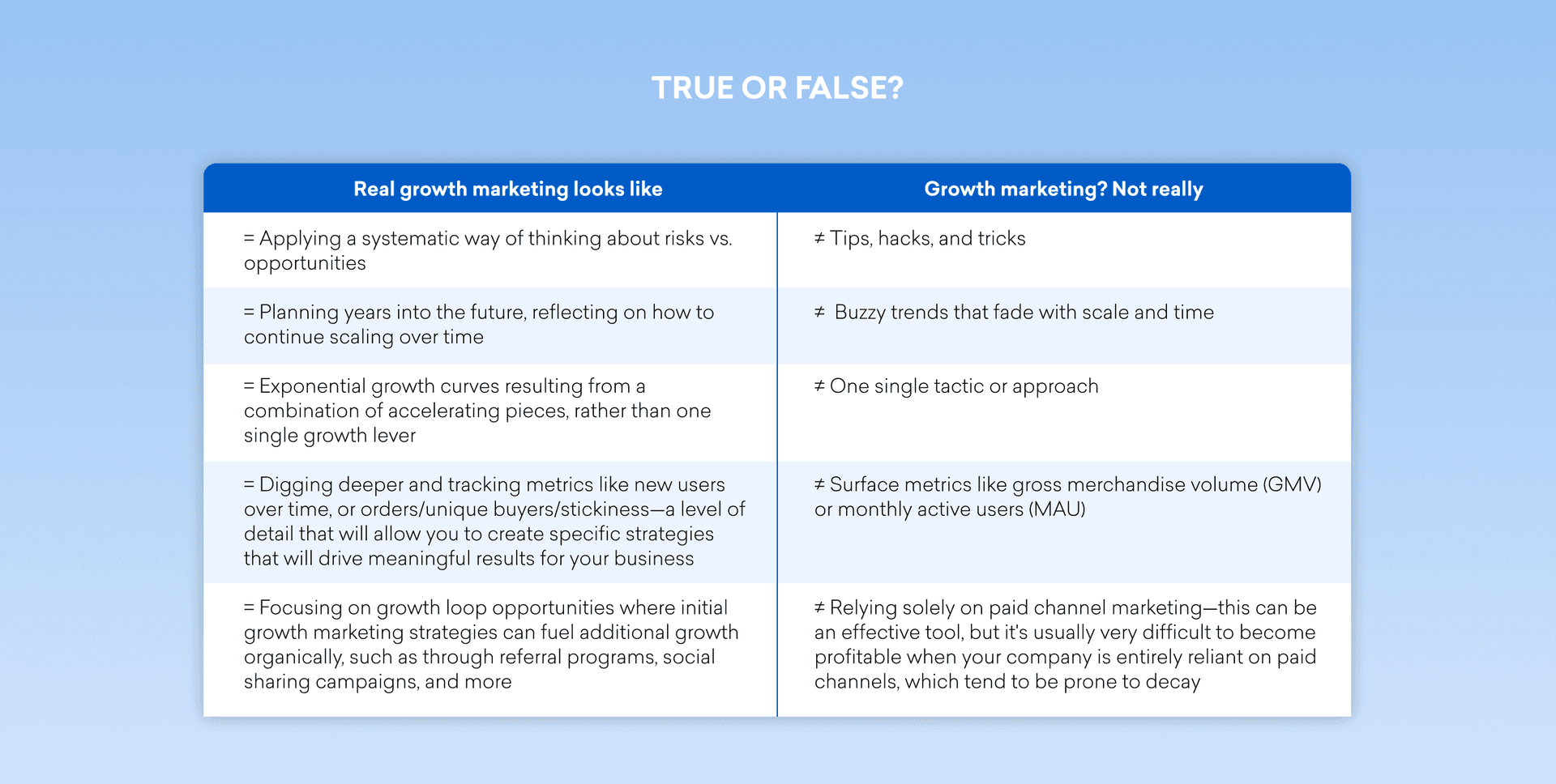
Real-world Examples of Growth Marketing Success
Upday, a free news app, and Clipchamp, a video editing program, both moved beyond their traditional marketing methods and platforms to leveraging growth marketing approaches that allowed them to re-engage users and give customers a more seamless and satisfying experience.
Their success was significant and measurable and gave further insight into their customer base, leading to more informed strategic growth marketing decisions they can implement as time goes on.
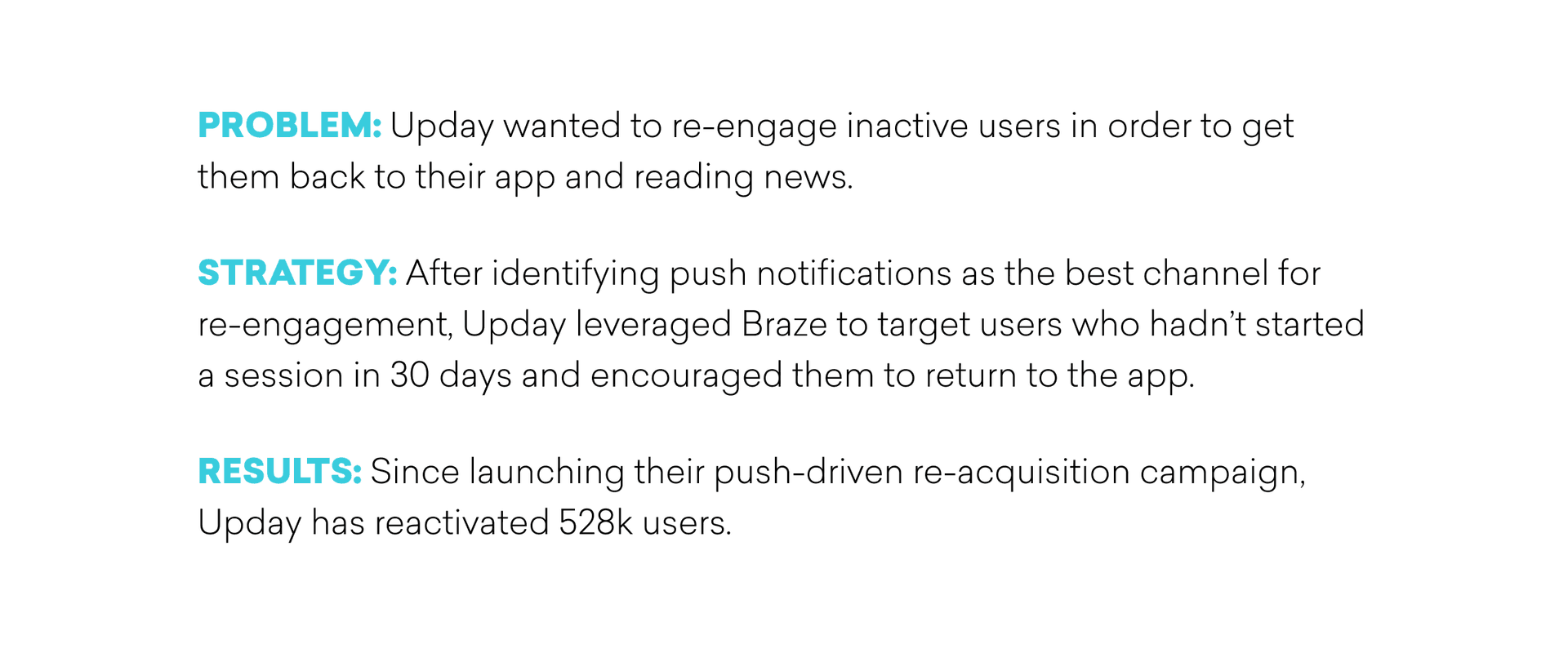
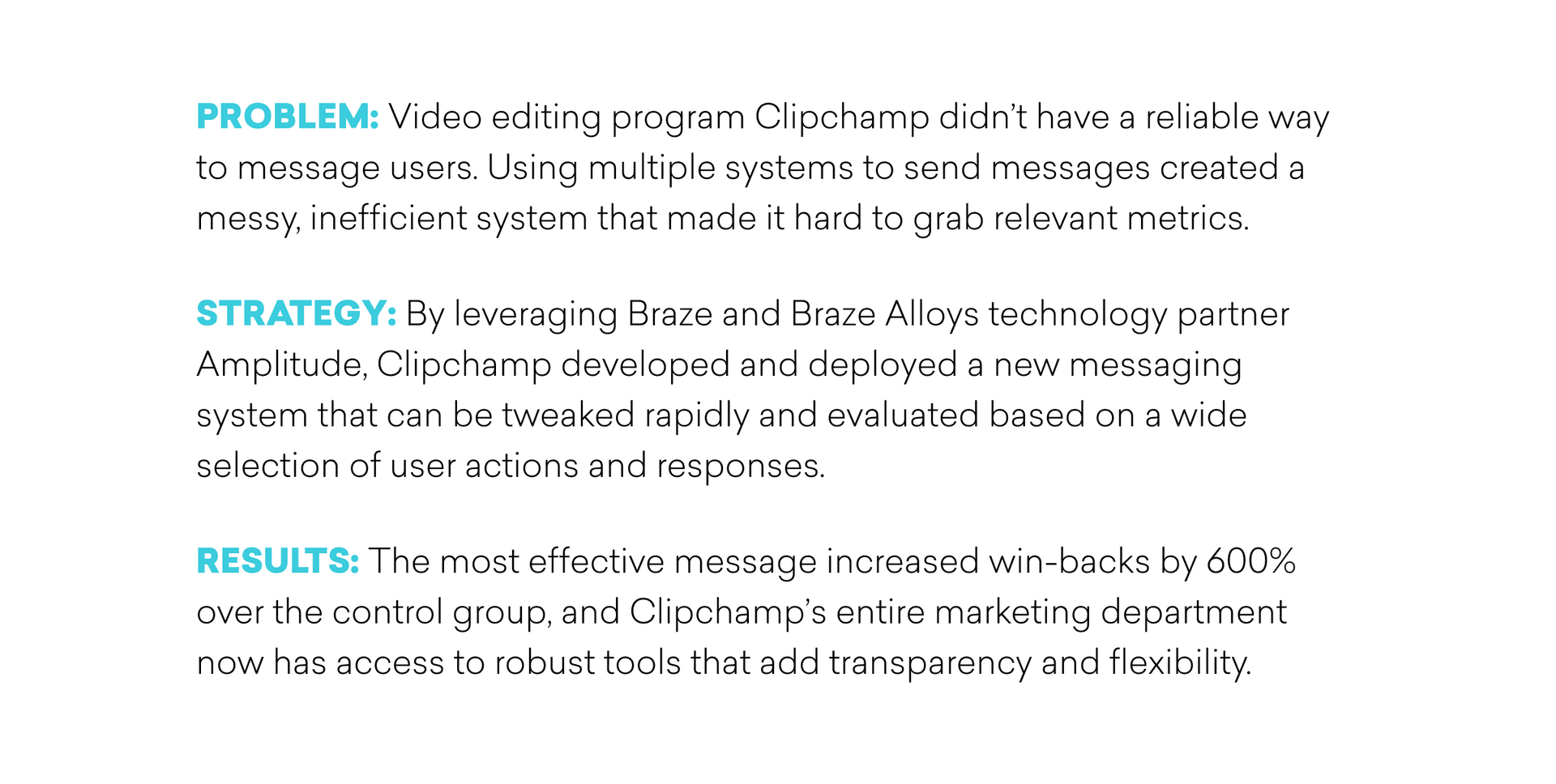
How to Create a Powerful Growth Marketing Campaign
1. Evaluate your ratio of CAC:CLV: Keeping your customer acquisition costs (CAC) in check in relation to overall customer lifetime value (CLV) is key to driving profits. Otherwise, you risk burning through your budget, spending more to generate less value than you're investing. That's why CAC needs to cost less than the value each customer generates. Overall, a 1:3 ratio is a smart benchmark to aim for.
2. Next, look at CAC and CLV by channel to find leaks or holes in your funnel. What's the breakdown of your customer acquisition in terms of organic vs. paid? Are word of mouth social referrals or sign-ups from Search Engine Optimization (SEO) helping keep your costs lower? Blended CAC (which includes both organic and paid together) tends to obscure what's driving the numbers you’re seeing, so it's important to drill down to the per-channel level.
3. Drive incremental profit at a low CAC: Scale and efficiency don't always go hand in hand. Spending more on marketing often means efficiency declines, while reducing your spend means that your efficiency generally improves, but at the cost of scale. Instead of a whole firehose of growth, you should be looking for a steadier drip drip drip of activity at a low CAC.
4. Analyze your retention curves: Good retention curves flatten out, and even better retention curves "smile." If your charts reveal continual decline, you may be filling a leaky bucket and trouble may be up ahead if you don’t course correct.
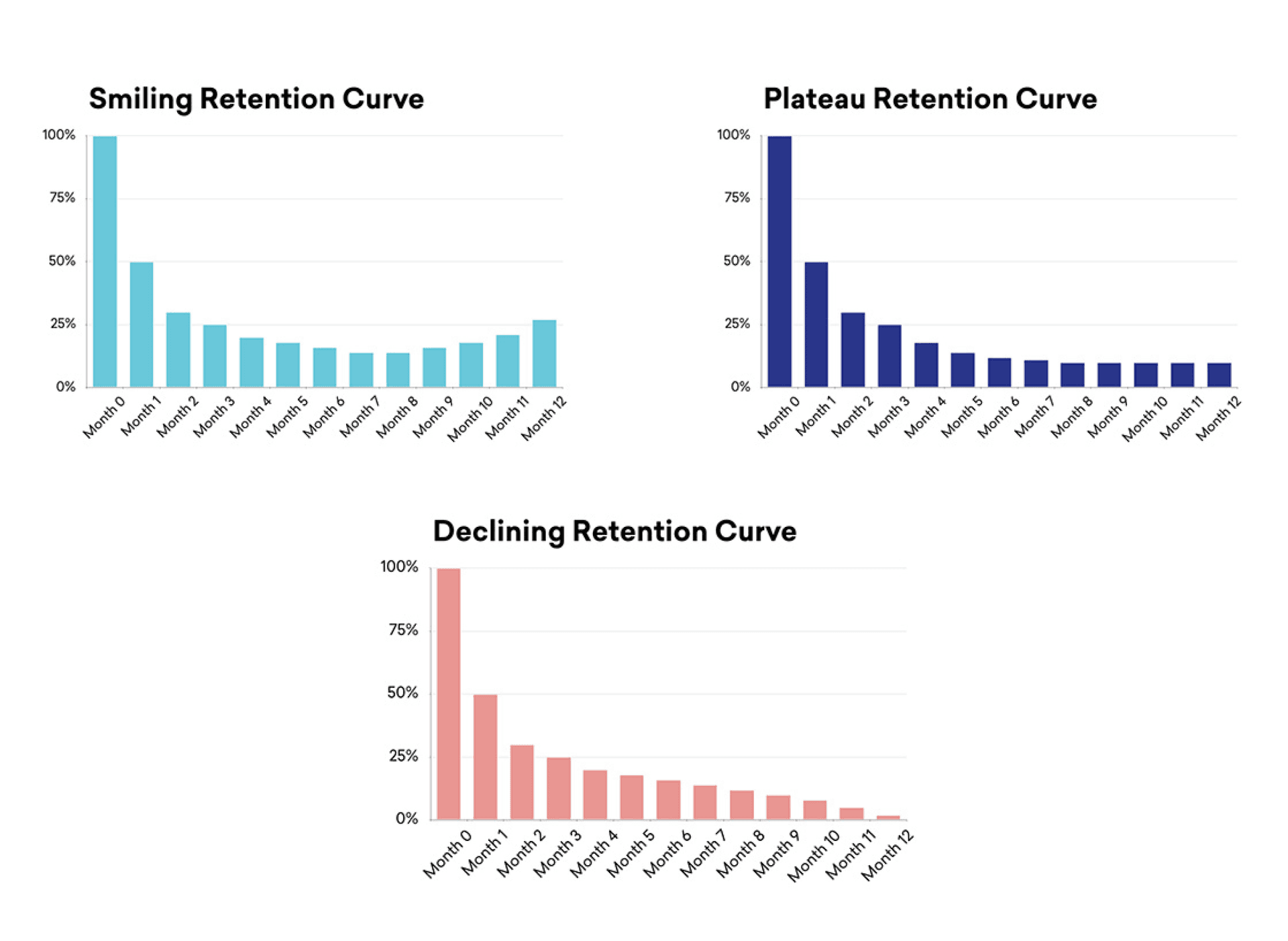
5. Cultivate high-value actions (HVAs) and keep an eye on negative-value actions (NVAs): HVAs are typically a set of customer actions that indicate greater longer-term business value for your company—think users who not only create a profile, but invite friends to join (growth loop!) or customers who complete their first order and save their payment method to their account. And negative value actions (NVAs), as the name suggests, are negative signals that highlight low-value conditions in your audience (say, shoppers who choose to check out as a guest rather than create a profile). To maximize growth, you need to keep an eye out for both.
To do that, you can segment users into engagement maps, and then guide these customer groups through their lifecycle with incentives, content, and customer education.
6. Go beyond growth and think about engagement: Almost every growth marketer knows how to optimize Search Engine Marketing (SEM), SEO, digital, social, and affiliate marketing. But there's a payoff to be had in thinking about the full customer journey and lifecycle marketing. Focusing on the entire funnel, not just acquisition, can help you to acquire more customers than you might think possible, plus increase your customer lifetime value, enabling you to spend more on acquisition marketing and to do so more effectively.
7. Get creative and ideate on potential growth loops, and marketing strategies that create a viral effect and bring more and more new users into the fold on an ongoing basis. These may include:
- Webinars and speaker series
- Free courses
- Referral programs
- Contests
- User-generated content campaigns
- Community building
- Customer reviews
How to Use Data in Growth Marketing
Data is essential to optimizing your growth marketing efforts. After all, you can't improve upon what you can't properly measure or see. That's why growth-minded brands are increasingly investing in data management and agility.
For companies to achieve true data agility, they need to be able to access the data they need, when and where they need it. When your data moves at the speed of your business to power seamless customer engagement across all interactions—whether online or off—that's data agility.
Data Disconnect
Too often, “data” ends up meaning different things to different people, especially across teams, departments, and organizations.
This is usually because the most essential business and customer insights can often be found sitting in siloed systems, leaving teams with conflicting and incomplete views of what overall growth and other important metrics look like.
Are You Aligned on Your Data Strategy?
To get an idea of this, ask yourself the following questions:
- Does your company/team have a shared understanding across the whole organization about the particulars of your data strategy?
- Are you on the same page about where and how data is being collected?
- What about how it’s being used and shared between teams?
- Have you defined your company's data quality standards?
What It Takes to Achieve Data Agility
#1: The right data infrastructure
- With the right setup, companies can seamlessly move the data they need between different tools, or better still, house it all in one place, providing a single view of each customer across departments—and, ultimately, guide better customer experiences and stronger growth outcomes.
- Flexible systems enable innovative companies to test out new, emerging technologies and tactics as well as strategies and ideas without being held up by the re-engineering of data pipelines or having to worry about losing historical data.
#2: A company-wide data culture
- Everyone who touches your data strategy should be encouraged and given the resources they need to access the information that supports their work.
- Brands need to establish a mentality of data democratization and work to identify and remove information silos.
The Evolution of the Data Stack: Are You Investing in a Framework to Fuel Data Agility?
We've come a long way since the early, pioneering heydays of closed, single-cloud marketing systems. Instead of relying on these legacy solutions from one-size-fits-none vendors, brands are creating more complex and more efficient systems built on platforms designed to meet specialized needs.
For many brands, translating growth into sustained customer engagement means leveraging a range of different technologies in connection with their growth marketing efforts and doing so in a thoughtful, coordinated manner. This focus on specialization has led to technologies that are leaps and bounds better than their predecessors.
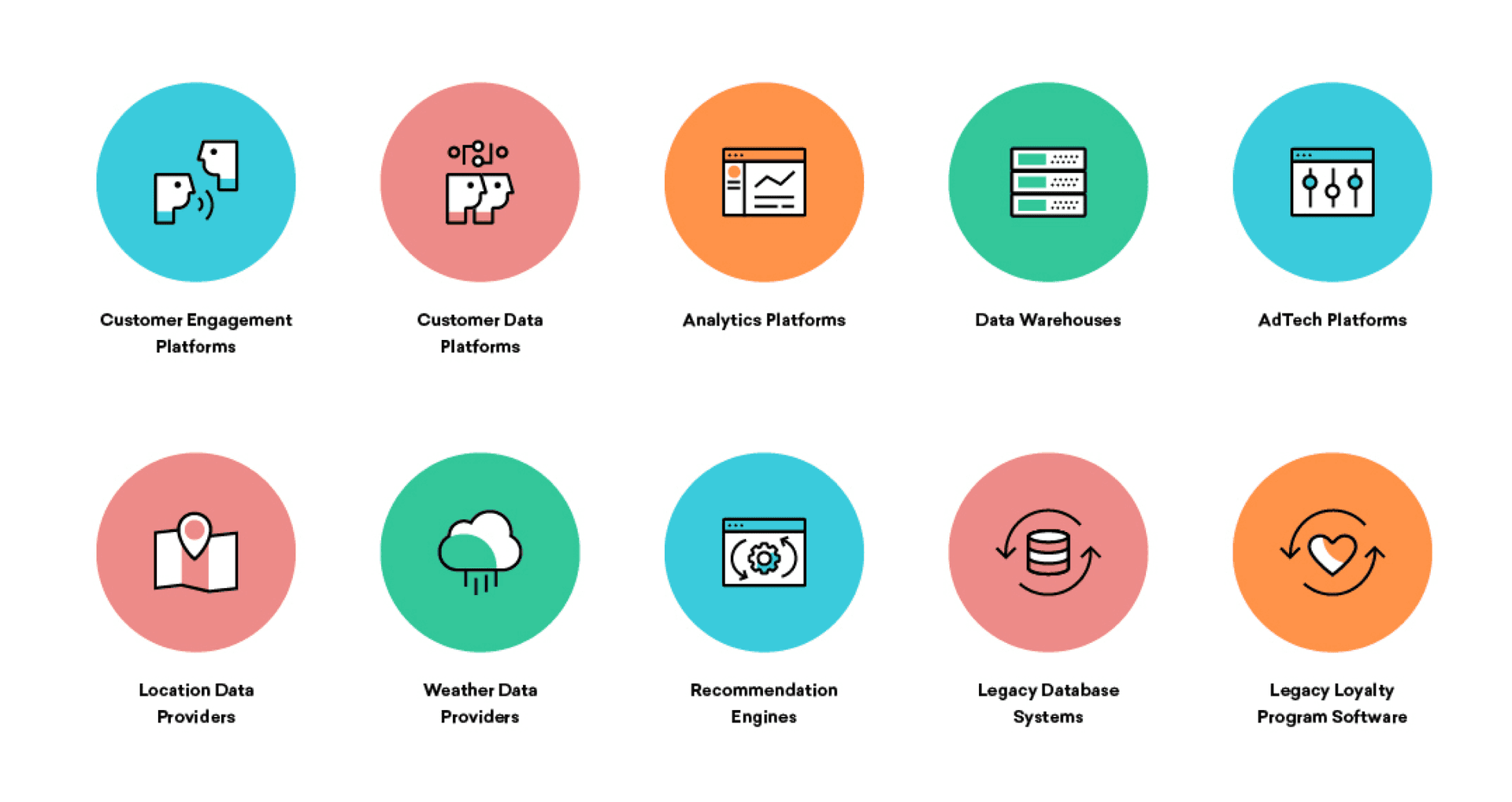
Different teams within a given organization have a variety of needs, and the rise of built-for-purpose marketing, engagement, and data management technologies has made it possible for brands to create unique technology ecosystems that are tailored to their teams’ particular needs and specific business goals.
And because companies aren't locked into a single provider, brands get the flexibility to add or substitute tools that aren’t cutting it. These hybrid stacks—built with best-in-class components—have shown themselves to be ideal for supporting today’s more agile marketing and sales operations, while also paving the way for more personalized and impactful customer experiences—the kind that fuel growth. This new generation of marketing tools has been created with data agility and connectivity in mind.
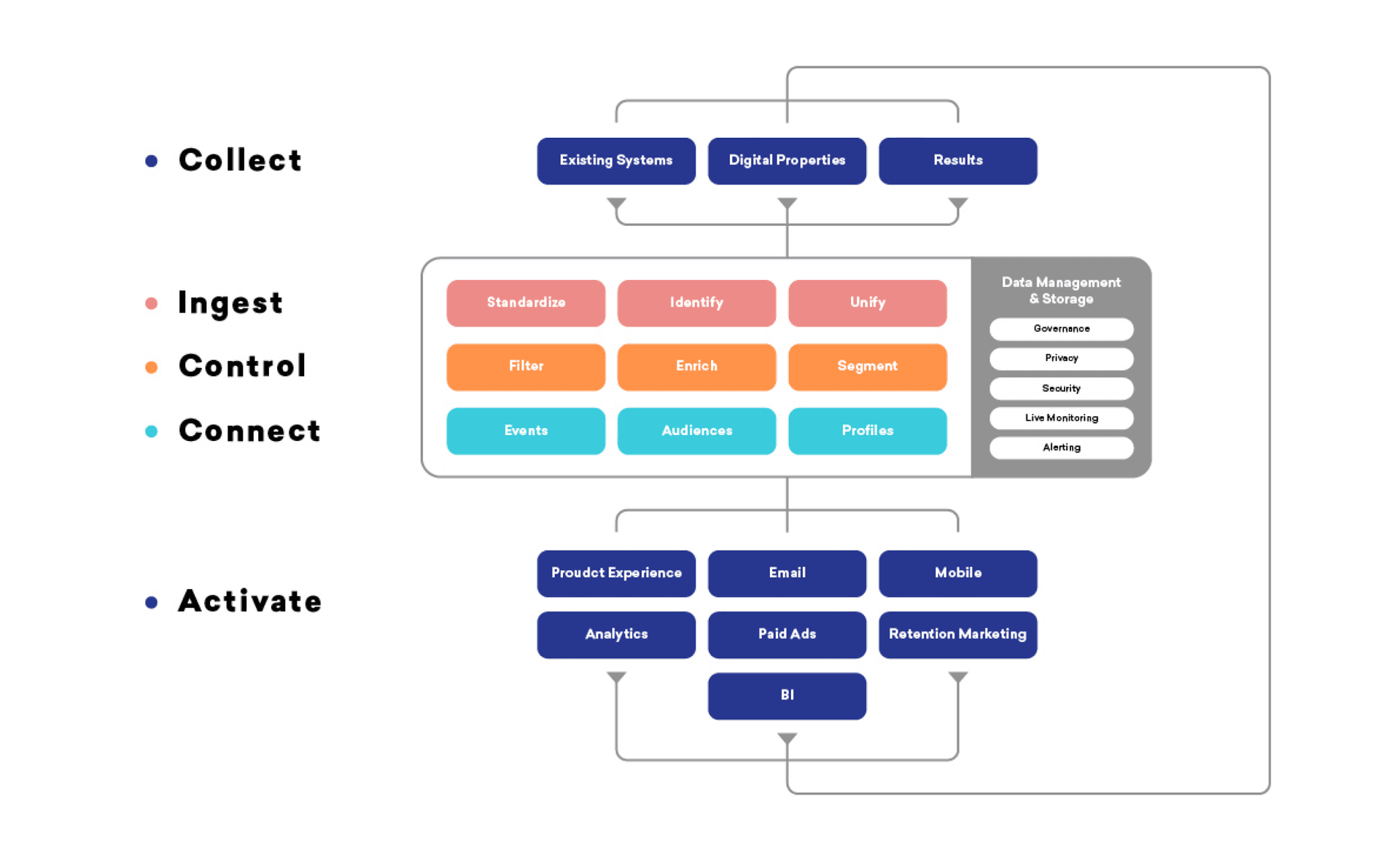
Successful brands build their ecosystems to manage data at every stage of the process—from acquisition and beyond—and to leverage feedback loops to support ongoing iteration.
Fit your stack to your marketing needs
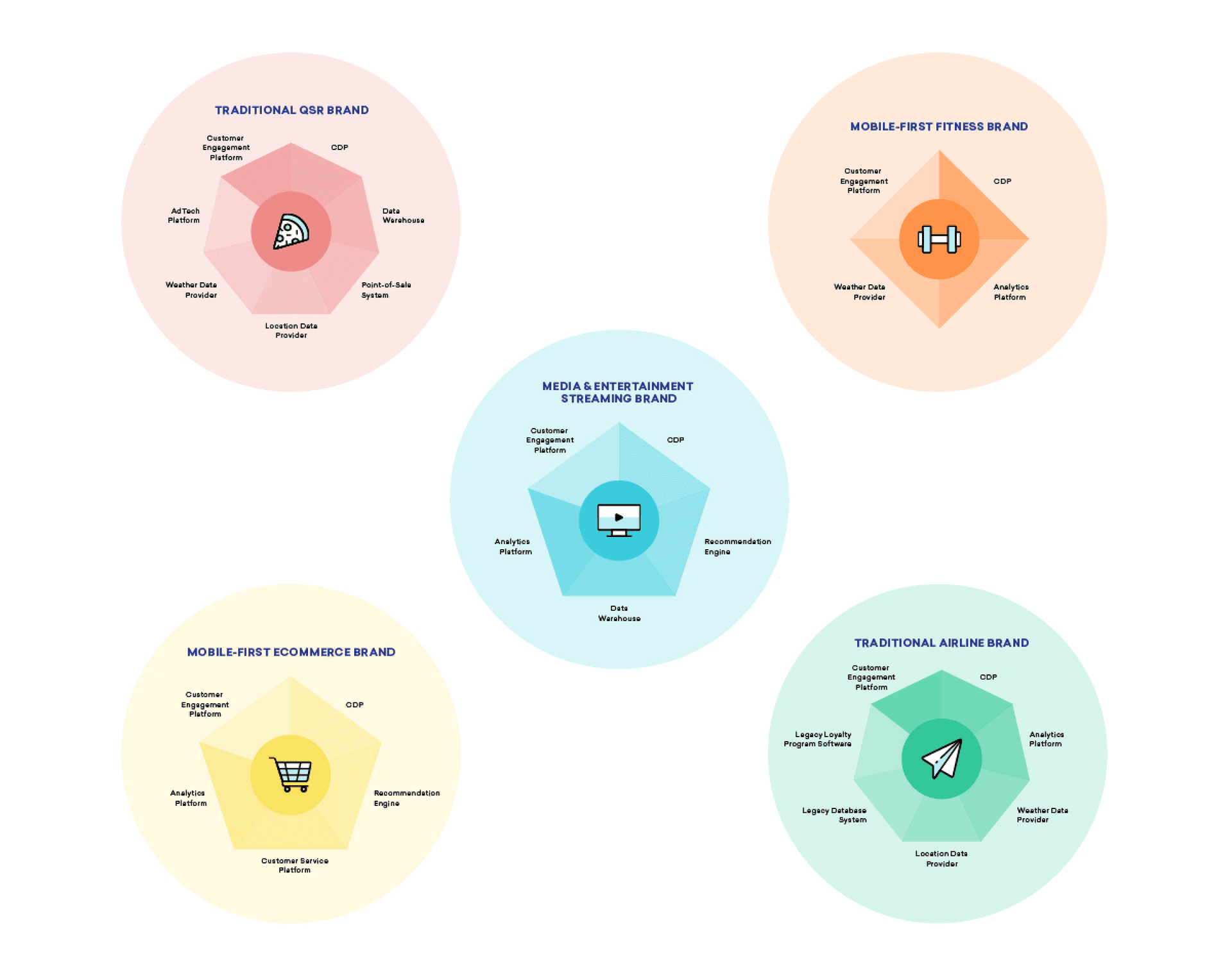
How Does Technology Influence Growth Marketing?
Companies that succeed at agile transformation can see a powerful return on their investment—by improving customer satisfaction, employee engagement, and operational performance, according to McKinsey & Company's analysis of 22 companies across six industries.
As we've written about, your brand’s marketing technology stack plays a major role in determining the long-term success of your growth, engagement, and retention efforts.
Get it right and you can provide the kinds of relevant, personalized, data-driven experiences that customers crave—and, importantly, keep them coming back for more. Get it wrong, and your brand may find itself serving up broken, frustrating experiences to its audience.
Does Your Tech Stack Stack Up?
To build a modern tech stack that supports growth and agility, you need to be clear about your organization’s needs—and the needs of your customers. While stacks vary based on these individual needs, your systems should enable you to…
- Track and process all of your key data
- Act on that data to reach your customers in responsive, meaningful ways
- Reach and engage customers across platforms and channels
- Integrate all of the tools and systems that matter to your customer growth and engagement strategies
- Eliminate silos
- Integrate AI developments
- Adapt and grow as needed to meet changing customer and business needs
And include key functionality like:
- Insights and analytics to learn and improve
- Testing to experiment and optimize
- Automation to reach customers in the moments that matter most
- Cross-channel support for push notifications, email, in-app, SMS, direct mail, WhatsApp, and more
- Data augmentation, such as recommendation engines and contextual information from location data platforms like Radar
- AI functionality and systems to recognize patterns and process large amounts of data
- Advertising integrations to support attribution, retargeting, and more
- Personalization features to engage users based on their interests and needs
No single ecosystem will be right for every brand or strategy. Keeping up with the evolving technology landscape and shifting customer expectations and tastes will often mean adjusting the solutions your team leverages to fit your current needs.
What Happens When Your Tech Can't Keep Up?
When brands can't store, access, and act on data, that's a major blocker of growth.
Data loses value over time, so when brands can't access it or struggle with latency issues, they're left with an incomplete picture of their business and customer growth opportunities. They can't act as quickly or efficiently. And these kinds of roadblocks can prevent even the most innovative companies from building a growth marketing program capable of driving long-term value. After all, timeliness is a competitive advantage.
And it's a drain on internal resources as well. Work that might otherwise be automated is manual, and when teams aren't able to streamline tasks, companies end up paying for their time.
10 Hidden Costs to Avoid
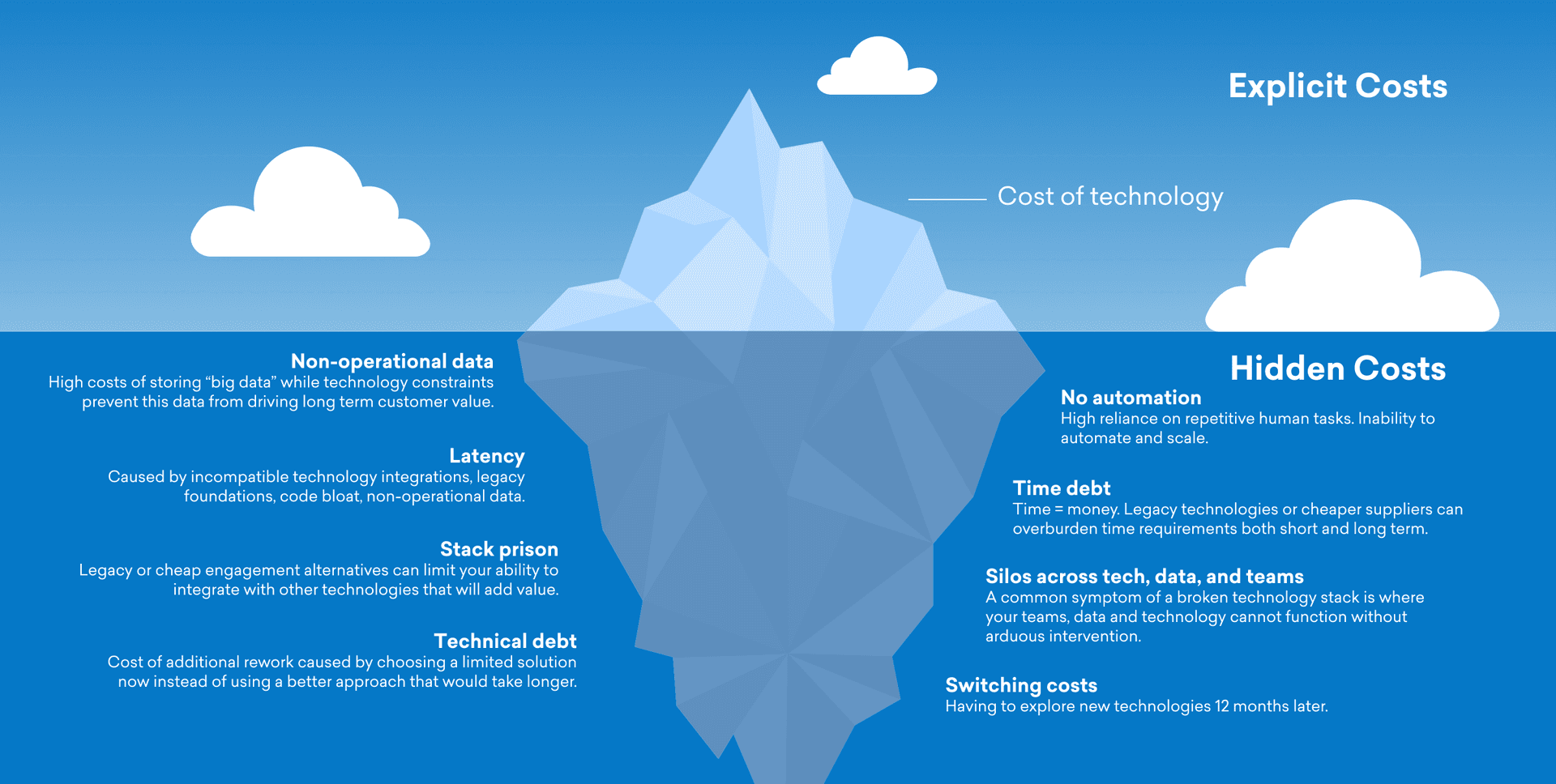
Explicit Costs
- Cost of technology
Hidden Costs
Non-operational data. High costs of storing “big data” while technology constraints prevent this data from driving long term customer value.
Latency. Caused by incompatible technology integrations, legacy foundations, code bloat, non-operational data.
Stack prison. Legacy or cheap engagement alternatives can limit your ability to integrate with other technologies that will add value.
Technical debt. Cost of additional rework caused by choosing a limited solution now instead of using a better approach that would take longer.
No automation. High reliance on repetitive human tasks. Inability to automate and scale.
Time debt. Time = money. Legacy technologies or cheaper suppliers can overburden time requirements both short and long term.
Silos across tech, data, and teams. A common symptom of a broken technology stack is where your teams, data and technology cannot function without arduous intervention.
Switching costs. Having to explore new technologies 12 months later.
The Importance of Building a Growth Team
It's been more than a decade since Facebook pioneered the first growth team. With about 50 million monthly active users (MAU) and relatively flat growth, Facebook invested in a growth team framework to launch into the giant we know today—with nearly 3 billion MAUs. Since then, there's been a rise in “Chief Growth Officers” at major enterprise brands across verticals.
Where Do Growth Teams Belong?
Y Combinator asked 25 growth experts at top startups and here's where they said growth teams fit within the org chart:
- Within product: 70% said growth teams usually live within a larger product team.
- Own team: 20% said growth teams are separate organizations. Facebook popularized this structure, but not all companies have found it works.
- Within marketing: 10% said growth teams are part of larger marketing teams. Since marketing teams are typically responsible for user acquisition, growth teams can often fall under this reporting chain, with the growth leader reporting to a CMO.
How to Structure Your Growth-Focused Team
Teams that follow growth strategies usually fall somewhere in the spectrum between being functionally organized or following the independent model.
The functional model assigns leaders to different functions, such as onboarding and signups. The leader of each function is in charge of what initiatives are used to promote that function’s growth.
The independent model is usually practiced in one of two ways: Either organized by shared metrics or organized by similar workflows.
The growth model your organization chooses will vary depending on your business and industry.Whether growth marketing lives within one function or on its own, it's also possible to build a growth mindset into the fabric of your entire company through modern and agile team building.
And, in fact, that's what many innovative enterprises are doing. Deloitte argues that with the average lifespan of S&P 500 companies shrinking from 60 years in the 1950s to 15 years in today's era, they can no longer afford the layers and bureaucracy of yesterday's corporation. That's why today, disruptive startups are shaking up well-established industries, empowered in part by their agile makeup and their networked—or cross-functional—teams.
"Today’s global operating environment is too unpredictable to rely on organizational structures devised over a century ago in order to adapt and respond to new challenges." —Unlocking the flexible organization: Organizational design for an uncertain future, Deloitte
Agile Team Building, 101
Siloed work environments are out and more effective cross-team collaboration to deliver promising growth is in. From hiring to rethinking the company org chart, here's how to get started on the path to transforming into an agile organization.
1. Hire experts/versatilists: These workers have the same sort of in-depth skills that can be traditionally found in specialists, but they're able to pair these with a wide set of responsibilities popularly associated with generalists, setting them up to be a fast-growing part of organizations. As for performance outcomes: Experts outperform beginners by 8:1 on average and as high as 100:1, in some circumstances.
2. Empower teams at all levels.
Focus on the skills of the people and build around them to enable a thriving team that can work in the most agile way possible. Invest in their development and give them opportunities to grow with autonomy. An empowered team will typically be more effective and more productive at every level.
3. Ditch your old org chart. Rethinking your org chart can boost innovation and lead to creative problem-solving. But it's important to make changes that are thoughtful—and stick. Start small. Choose a particular team or department as a test case.
4. Iterate to innovate. Agile transformation doesn't happen all at once. Focus on creating a culture of learning and growth and be prepared for smaller, incremental gains over time.
5. Eliminate silos, encourage communication. Create an environment where people feel comfortable enough to bounce creative ideas off of each other to fuel positive outcomes.
Examples of Real Brands Use a Data and Tech-Driven Growth Marketing Strategy
How HBO Max Creates Personalized Campaigns for Super Fans in Latin America With In-App Message Surveys From Braze
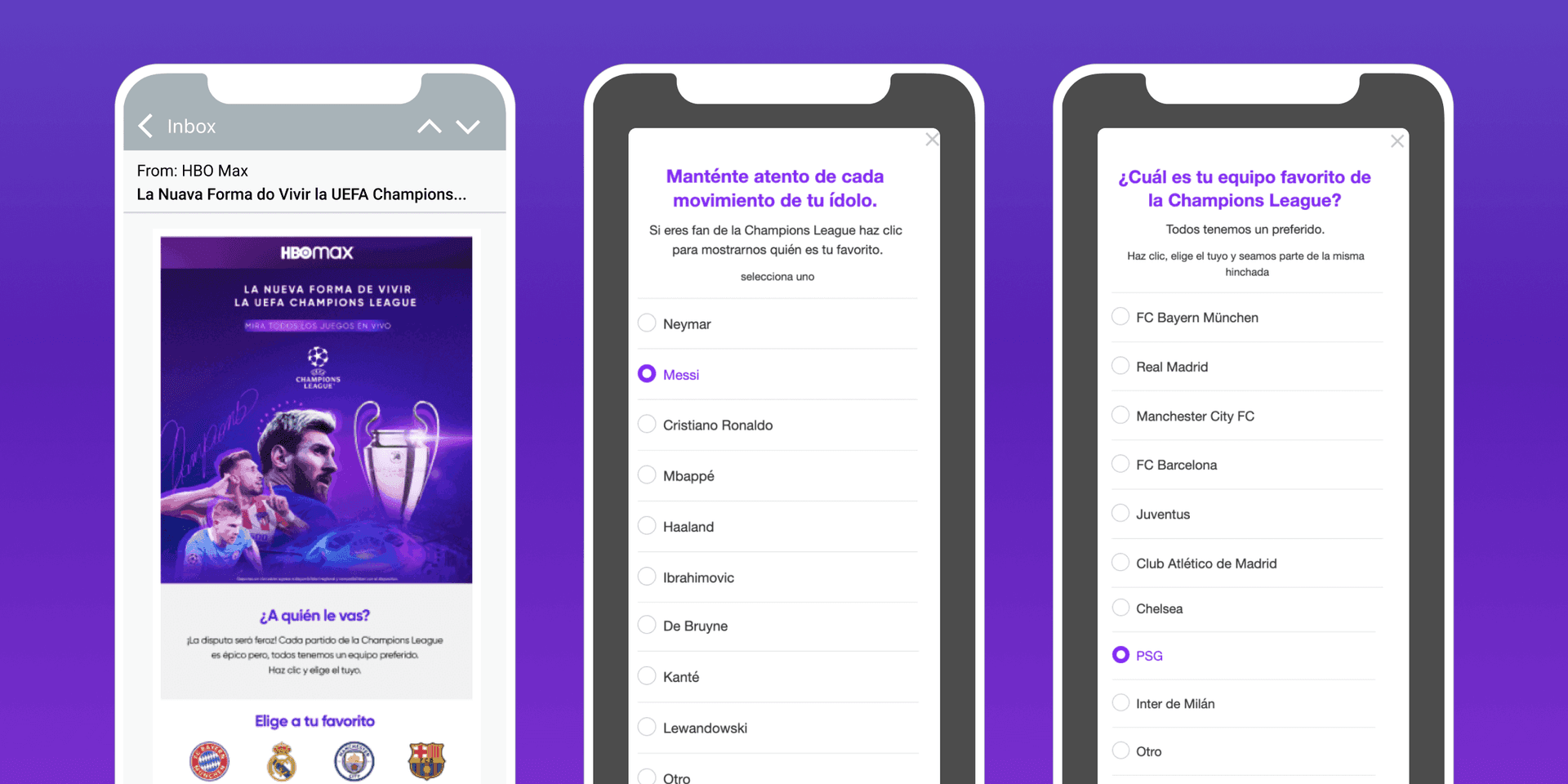
Problem
HBO Max is a subscription-based video-on-demand service. They wanted a scalable, marketer-friendly customer engagement platform that could help them personalize messages to each user in Latin America.
Strategy
Leveraging in-app message (IAM) surveys and follow-up messaging from Braze, HBO Max targeted fan bases that were extremely passionate across three of their content offerings. They collected zero-party data and provided more tailored experiences for their users.
Results
HBO Max saw 35% to 50% survey participation across Harry Potter, DC Comics fans, and Champions League. By using Braze IAMs to support their data-driven growth strategy, they saw a 40% lift in CRM communications performance and a 15% overall lift in engagement and churn prevention. Read the full case study.
How Payomatic Boosted Mobile App Adoption and LTV with Data-Driven Marketing
Problem
Financial services brand Payomatic wanted to make the leap toward digital transformation and expand its business from a brick-and-mortar base to include a mobile app. While in the past, the company had primarily relied on advertising and in-store cross-selling to guide growth, by partnering with Braze and Braze Alloys technology partner Snowflake, the brand was able to adapt its marketing and deliver its outreach straight to customers, encouraging high-value activities, like enrolling in direct deposit, reloading prepaid cards, and sending money to friends and family.
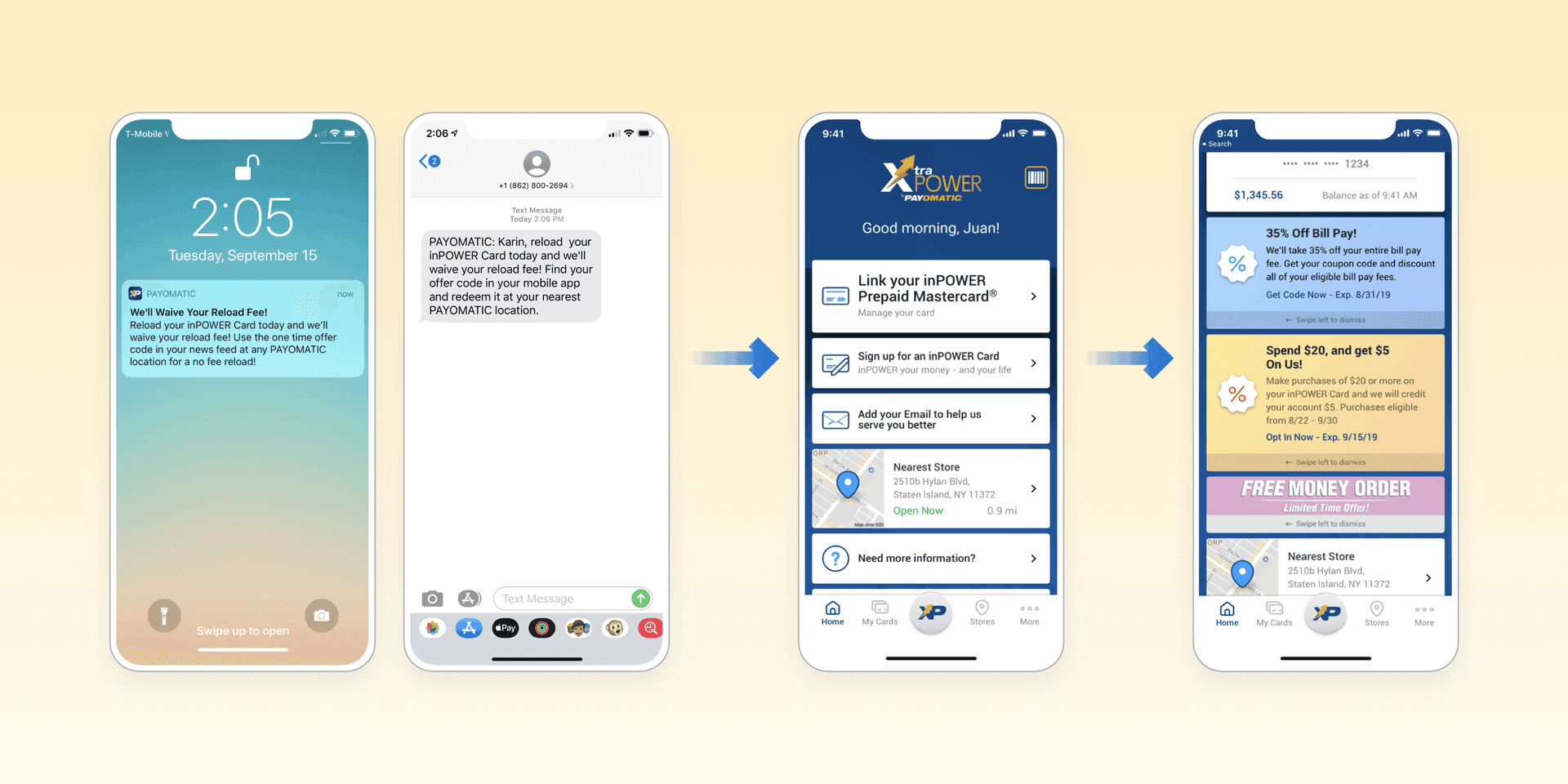
Strategy
By reaching out to customers directly to guide them along their financial journey, Payomatic generated higher adoption and engagement for its mobile app and increased customer lifetime value. Customers are being onboarded more effectively, engaging with the app more often, and converting to more high-value behaviors. (Read the full case study.)
Results
Payomatic’s use of Braze drove a 32% uplift in direct deposit adoption via its mobile app, an 11% increase in mobile app engagement, and a 50% prepaid cardholder mobile app penetration.
Final Thoughts
The need for smart, ongoing experimentation has never been clearer—or more critical. The first step toward reaching consumers in today’s stressful, cluttered digital environment means embracing growth marketing principles and leveraging them across new channels, mediums, and touchpoints.
Whether that’s web push notifications, SMS, OTT messaging, or even direct mail, brands need to take advantage of the many tools available to reach their consumers.
Not only that, in order to meet today's challenges, truly growth-oriented brands are approaching their customer engagement in a consistent, coordinated, and compelling way, and that means adopting a true cross-channel messaging strategy. One that can be deployed across their ecosystem and personalized for every customer.
Featured Resources
- Customer Lifecycle Marketing 101: What it is (and What You Need to Know)
- What’s Data Agility?
- Trust, But Verify: How to Make Sure Benchmarks Are Really Saying What You Think They’re Saying
- The Six Pillars of Braze Alloys: Insights
- Stacks, Ecosystems, and Customer Engagement: Where Are We Now?
- Marketing Automation: What Is it and Why Is it Important to Your Marketing Strategy?
- The Six Pillars of Braze Alloys: Data Augmentation
- Why Marketers Should Care About Data Latency
- Modern Teamwork: How to Assemble and Manage Agile Teams To Support Brilliant Customer Experiences
- Your Silos Are Showing: The How and Why of Fostering Collaboration at a Time of Accelerating Digital Transformation
- Braze Alloys: Extend the value of Braze by connecting with a trusted partner
- Braze Partners: Amplitude
- Braze Partners: Segment
- Braze Partners: Snowflake
- Case Study: Payomatic Boosts Mobile App Adoption and Lifetime Value with Data-Driven Marketing
- Brilliant Experiences, Channel by Channel
- What’s OTT Business Messaging?
Related Tags
Be Absolutely Engaging.™
Sign up for regular updates from Braze.
Related Content
View the Blog
How AI Decisioning Transforms Marketing (A Complete Guide)

Team Braze

AI decisioning cheat sheet: How to crawl/walk/run with BrazeAI Decisioning Studioᵀᴹ

Team Braze

A day in the life of a data scientist on the BrazeAIᵀᴹ forward-deployed engineering team
